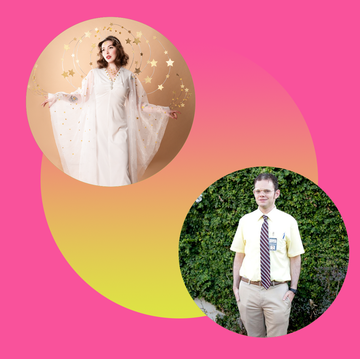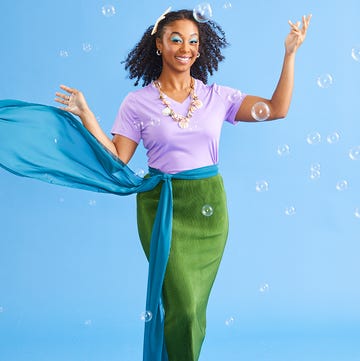Who Celebrated Halloween First?
 Getty Images
Getty ImagesHalloween Has a Dark Spiritual History
 David Wall//Getty Images
David Wall//Getty ImagesThe Celts also believed that the spiritual communication on Samhain made it easier for Celtic priests, or druids, to predict the future, according to History. To appease the deities, they built bonfires and sacrificed crops and animals. Villagers also attended the bonfire ceremonies wearing animal heads and skins, which may be where the tradition of Halloween costumes first came from.
Advertisement - Continue Reading Below
Bats are a Halloween Symbol
 Peter Finch//Getty Images
Peter Finch//Getty ImagesNowadays, many of us associate bats with Halloween — and that has historical roots, too. The Druids' Samhain bonfires attracted bugs which, in turn, tempted bats to a tasty feast. In later years, various folklore emerged citing bats as harbingers of death or doom. In Nova Scotian mythology, a bat settling in a house means a man in the family will die. If it flies around and tries to escape, a woman in the family will perish instead.
Romans Had Their Own Fall Festivals
 Getty Images
Getty ImagesThe Romans conquered most Celtic territory by 43 A.D. and brought their culture's fall festivals with them, according to History. A Roman October celebration called Feralia also commemorated the passing of the dead. Another holiday, Pomona, honored the Roman goddess of fruit and trees. That's one reason people often bob for apples during Halloween parties.
Advertisement - Continue Reading Below
Christians Are Behind Why Halloween Is on October 31
 Getty Images
Getty ImagesFast forward a few centuries, and the festivals that would become Halloween had evolved. Several Christian popes attempted to replace "pagan" holidays like Samhain with their own religious observances. By 1000 A.D., All Souls' Day on November 2 served as a time for the living to pray for the souls of the dead. All Saints' Day, or All Hallows, honored the saints on November 1. That made October 31 All Hallows Eve, which later became Halloween.
The British Set Out Ghostly Gifts
 Getty Images
Getty ImagesDespite the new religious focus, people in Old England and Ireland continued to associate the end of October with the dead wandering among us. They set out gifts of food to satisfy hungry spirits, and as time wore on, people began dressing in creepy costumes to go begging for the treats themselves. The practice was called "mumming," and looked similar to today's trick-or-treating.
RELATED: 30 Scary Halloween Costume Ideas to Try
Advertisement - Continue Reading Below
The Southern Colonies Brought it Stateside
 Getty Images
Getty ImagesThe first Halloween-like festivities in America started in the southern colonies. People began to celebrate the harvest, swap ghost stories and even tell each other's fortunes, traditions that they probably brought with them from their countries of origin.
Women Bobbed for Apples (and Husbands)
 Getty Images
Getty ImagesIn the 1700s and 1800s, unmarried women performed rituals on Halloween in hopes of finding a husband. Single ladies used to throw apple peels over their shoulders, hoping to see their future husband’s initials in the shapes they made where they fell. They also competitively bobbed for apples at parties, believing the winner would marry first. And in a ritual that sounds downright creepy, some thought standing in a dark room with a candle in front of a mirror would make their future husband's face appear in the glass. Blood Mary, anyone?
Advertisement - Continue Reading Below
The Irish Introduced Jack-o'-Lanterns
 Getty Images
Getty ImagesThe holiday we celebrate as Halloween today really started taking off in the U.S. in the middle of the 19th century, when a wave of Irish immigrants left their country during the potato famine. The newcomers brought their own superstitions and customs, including the jack-o'-lantern. But back then, they carved them out of turnips, potatoes and beets instead of pumpkins.
RELATED: The Best Way to Carve a Pumpkin for Halloween
Halloween Focuses on Treats Today
 Getty Images
Getty ImagesBy the end of the 1800s, more communities were partaking in a more secular (and safer) set of rituals. People started holding parties that included harmless Halloween games, fall seasonal treats and fun costumes over witchcraft and mischievous troublemaking.
RELATED: 80+ Fun Halloween Party Ideas
Advertisement - Continue Reading Below
Americans Spend a Lot on Candy
 Getty Images
Getty ImagesTrick-or-treating skyrocketed in popularity by the 1950s, when Halloween became a true national event. Today, over 179 million Americans celebrate the holiday — and spend about $9.1 billion annually in the process, according to the National Retail Federation. That's a lot of miniature candy bars!
Halloween Is Not a Federal Holiday
 Rebecca Nelson//Getty Images
Rebecca Nelson//Getty ImagesWhile Halloween is lots of people's favorite holiday, the day isn't a federal holiday. Despite all of the festivities that happen in the evening, it's still a work day and most businesses and banks follow their regular hours. So if you're rushing home to answer your doorbell, you're certainly not the only one.
RELATED: What Time Does Trick-or-Treating Start?

Caroline is a writer and editor with almost a decade of experience. From 2015 to 2019, she held various editorial positions at Good Housekeeping, including as health editor, covering nutrition, fitness, wellness, and other lifestyle news. She's a graduate of the Medill School of Journalism and dreams of the day Northwestern will go back to the Rose Bowl.

Lizz (she/her) is a senior editor at Good Housekeeping, where she runs the GH Book Club, edits essays and long-form features and writes about pets, books and lifestyle topics. A journalist for almost two decades, she is the author of Biography of a Body and Buffalo Steel. She also teaches journalism as an adjunct professor at New York University's School of Professional Studies and creative nonfiction at the Muse Writing Center, and coaches with the New York Writing Room.
Advertisement - Continue Reading Below
Advertisement - Continue Reading Below
Advertisement - Continue Reading Below


























